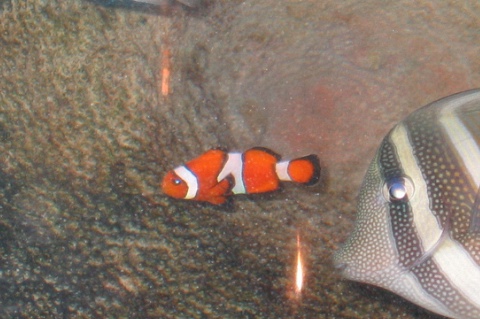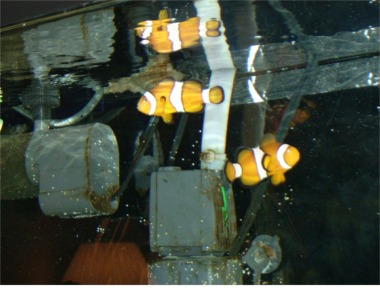|










| |
Amphiprion
ocellaris
Also Known As:
Anemonefish, Common
Clownfish, Ocellaris Clownfish, False Percula Clownfish, Clown
Anemonefish, "Nemo", Western Clownfish |
|
Domain –
Eukarya
Kingdom –
Animalia
Phylum –
Chordata
Class –
Actinopterygii
Order –
Perciformes
Family –
Pomacentridae
Genus – Amphiprion
Species – Amphiprion
ocellaris
|

Picture taken by Betsy Berends |
|
Amphiprion ocellaris
is in the domain eukarya because it is eukaryotic, meaning its
cells contain
membrane-bound organelles. The species' kingdom is animalia because
it is a multicellular,
heterotrophic, motile
species, whose cells lack cell walls. The clownfish is in the phylum
chordata because the species has tissues, a
coelom, and did have a
notochord during its early development. Also, it possesses a
dorsal,
tubular nerve chord, and postanal tail, which are two key
characteristics of chordates. The species is also bilaterally
symmetrical, which all chordates are. The class is actinopterygii because Amphiprion
ocellaris is a ray-finned, spiny fish. Amphiprion ocellaris
is in the order perciformes
because this species is a perch-like fish. Its family is Pomacentridae because it is a damselfish that dwells in coral and
uses chemicals to locate its host. All anemonefish belong to the
genus
Amphiprion. This particular ordering in the genus
Amphiprion occurred in 1801, when two men, Bloch and Schneider,
grouped all anemonefish together. These
particular fish were grouped together because they are all
protandrous hermaphrodites, meaning
they are all born males with dormant female reproductive organs. Over
time, some males may change into females in order to reproduce more
fish. (See also Reproduction). This particular
species is given the scientific name of Amphiprion
ocellaris. This genus name is specific to the
clownfish. In Latin, ocellaris means "a (little) eye."
Clownfish do not actually have little eyes, but rather eyes with
grayish-orange irises that make their eyes appear larger than they truly
are. This particular feature, however, separates them from all
other anemonefish. (See also
Fun Facts).
Thus, the name Amphiprion ocellaris means the opposite of what is
true about the clownfish.
|
|

A hypothesized phylogenetic tree for Amphiprion ocellaris.
|
|

Picture taken by Elizabeth Guck |
There is strong evidence that anemonefish are
monophyletic. The
clownfish genera, Amphiprion, is closely related to the
genera Premnas, which consists of other pomacentrid fish.
Amphiprion ocellaris is the most
basal of all the Amphiprion
species, while Premnas are the most ancestral anemonefish species
known, which means that Amphiprion species are derived from
Premnas species. Since A. ocellaris is specialized to one or two host
anemone species, while other anemonefish of the same genus are not, it
can be concluded that host generalization came after the clownfish.
Thus, the clownfish is the more ancient than the other anemonefish.
Also, the clownfish is related to the other bony fish, particularly the
ray-finned fish, which are part of the class Osteichthyes. This class
is closely associated with the class Chondrichthyes, which are the
cartilage fish, such as the sharks and rays. Therefore, in
conclusion, Amphiprion ocellaris is the most basal species in the
genus Amphiprion, which is closely related to the genera
Premnas and the class Chondrichthyes. For more information
about what separates Amphiprion ocellaris from other Amphiprion
species, see Fun Facts. |
| |
|
Send comments about this page to
Betsy Berends,
berends.bets@students.uwlax.edu,
a student at the University of Wisconsin
- La Crosse
This page was last updated on
April 23, 2007
Back to Top |
|


